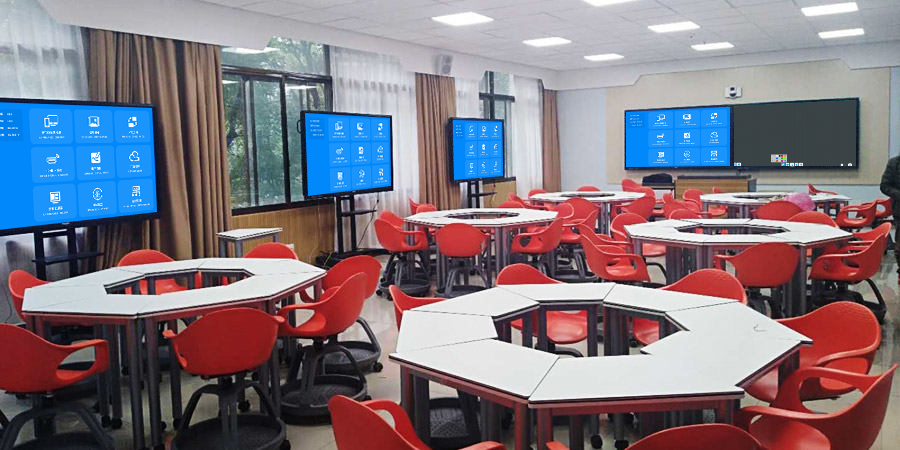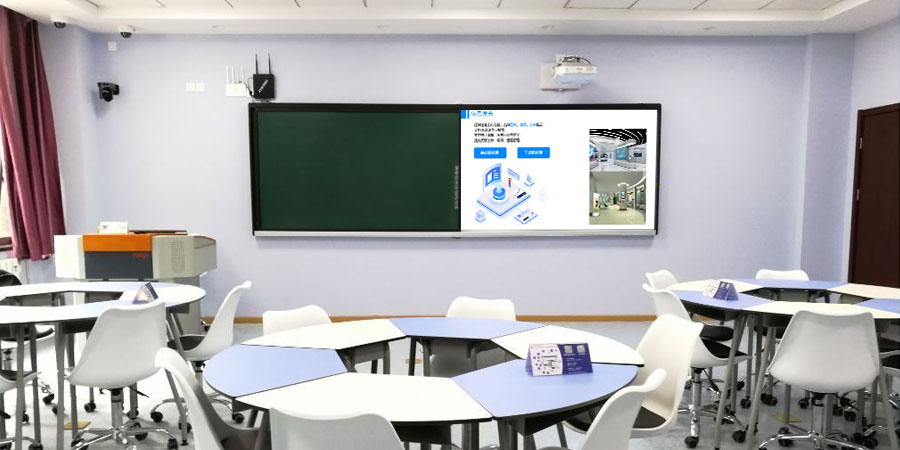Smart Classrooms: Building a New Ecosystem for Intelligent Teaching
The smart classroom solution is centered on “technology integration with education.” By leveraging intelligent device linkage and data-driven insights, it creates a modern teaching space that combines interaction, management, and resource sharing, driving a transition from traditional to intelligent teaching models.
I. Intelligent Technology Architecture
The system uses a “cloud + edge + end” collaborative architecture. The core devices include a 4K touch main screen, an AI recording system, a wireless screen mirroring terminal, and student interactive tablets. It supports all-protocol wireless connections, allowing iOS, Android, and Windows devices to mirror with a single click and a latency of just 30ms. Edge computing nodes enable rapid local data processing, ensuring stable system operation even when multiple devices are running at the same time.
II. Core Intelligent Features
- AI Classroom Assistant: Automatically recognizes the teacher’s gestures and voice commands to control actions like flipping courseware pages and switching mirrored screens. It also analyzes the classroom atmosphere in real time to generate a focus report, helping the teacher adjust the teaching pace.
- Precision Teaching System: Student answer data is uploaded in real time. The system automatically identifies weak knowledge points and pushes targeted practice exercises. It also supports differentiated instruction, allowing teachers to send different learning resources to students of varying skill levels.
- Intelligent Resource Management: Course content is automatically categorized and stored, forming a school-based resource library. It supports quick retrieval by knowledge point, boosting teacher lesson preparation efficiency by 40%. Class recordings automatically generate indexed replays, making it convenient for students to review after class.

III. Scenario-Based Teaching Practices
- Immersive Theory Classes: A teacher can mirror an AR courseware, allowing students to view 3D models on their tablets in a 360° view. The AI assistant can annotate key content in real time and automatically generate notes that are pushed to student terminals, making abstract knowledge tangible.
- Inquiry-Based Lab Classes: Experimental data from sensors is mirrored to the main screen in real time, and the system automatically draws curves and analyzes abnormal points. Students can record observations on their tablets, mirror them to the large screen, and have a class-wide discussion, cultivating scientific inquiry skills.
- Cross-School Collaboration: The system enables two-way screen mirroring with schools in remote areas. A high-quality teacher can give a lecture from a virtual podium, and students from both locations can work in groups to complete projects, sharing experimental data and discussion results to promote educational equity.
IV. Smart Management System
- Remote Operations and Maintenance Platform: Administrators can monitor device status in real time, troubleshoot problems remotely, and automate firmware updates, reducing maintenance costs by 60%.
- Granular Permission Control: Permissions are tiered for “teacher, student, and visitor.” The teacher has control over resource pushing and interactive features, while students can only access course-related content, ensuring classroom order.
- Intelligent Energy Management: Devices are automatically turned on and off according to the class schedule, and they enter an energy-saving mode during unoccupied hours, reducing annual energy consumption by over 30%.
This solution has been implemented in over a hundred schools nationwide. Teacher preparation time has been reduced by 50%, and student grades have improved by an average of 15%. This truly empowers education with technology, making teaching more efficient and learning more proactive.